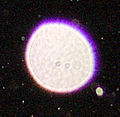
orb describes unexpected, typically circular artifacts in photographs. Sometimes the artifact leaves a trail, indicating motion.
The technical photographic term for the occurrence of orbs, especially pronounced in modern ultra-compact cameras, is backscatter, orb backscatter or near-camera reflection.
| |
Cause
Due to the size limitations of the modern compact and ultra-compact cameras, especially digital cameras, the distance between the lens and the built-in flash has decreased, thereby decreasing the angle of light reflection to the lens and increasing the likelihood of light reflection off normally sub-visible particles. Hence, the orb artifact is commonplace with small digital or film camera photographs.
The orb artifact can result from reflection of light off solid particles (e.g., dust, pollen), liquid particles (water droplets - especially rain) or other foreign material within the camera lens.
The image artifacts usually appear as either white or semi-transparent circles, though may also occur with whole or partial color spectrums, purple fringing or other chromatic aberration. With rain droplets, an image may capture light passing through the droplet creating a small rainbow effect.
Underwater photographers notice the effect also, which occurs for the same reason as above-water photographic artifacts. Sand, small sea life or other particles close to the lens, invisible to the diver, reflect light from the flash causing the orb artifact in the image. A strobe flash, which distances the flash from the lens, eliminates the artifacts.
Example images
Examples of orb artifacts reflecting solid or liquid particles:
| Rain orbs with coma (tails) and chromatic aberration visible | Close up orb, showing purple fringing and the |















